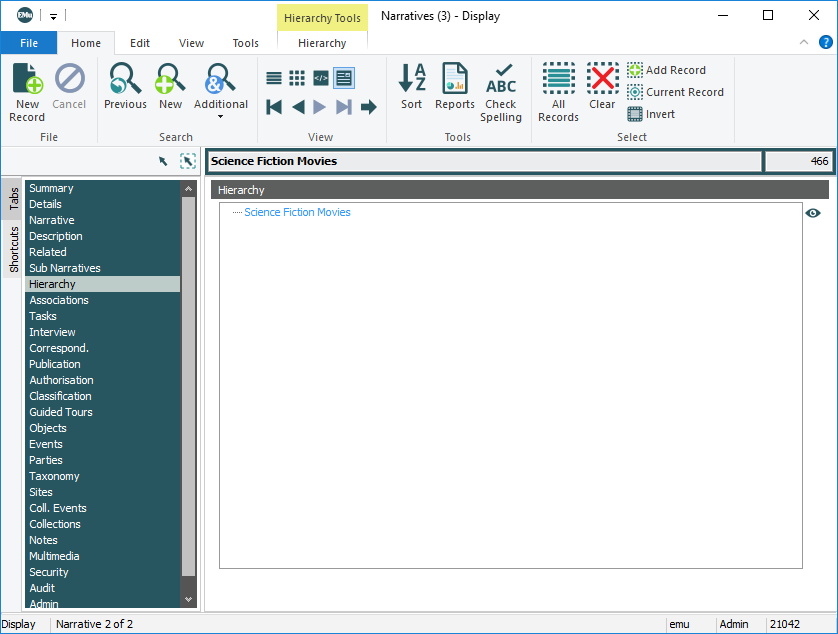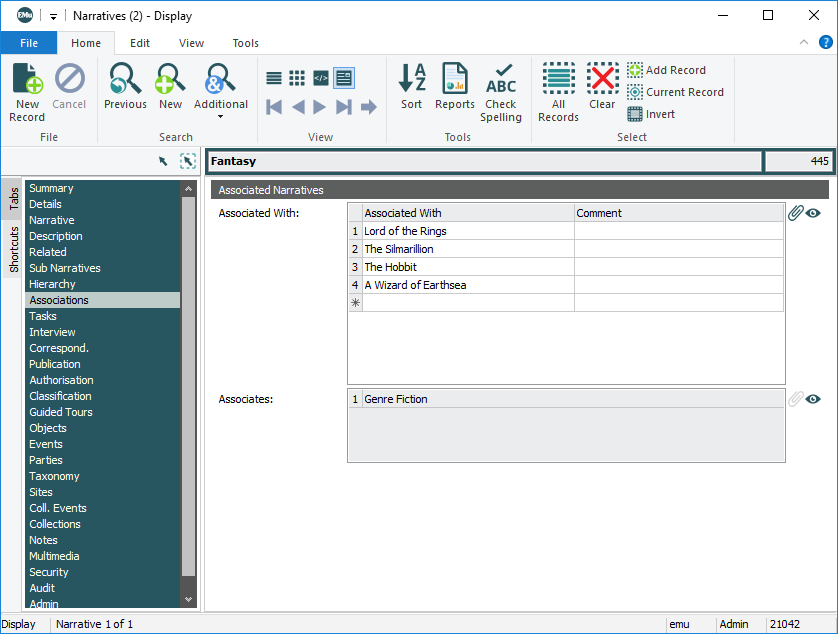The approach By Association is a more flexible way to structure narratives than the Hierarchical approach. As with the Hierarchical approach, By Association involves establishing a hierarchy of narratives, but in this case using the Associated Narratives fields on the Associations tab:
In this example, two narratives are associated with a narrative immediately above them in some kind of logical relationship: the higher level narrative is a general discussion of novels written by P.K. Dick in the 1960s, and the two associated narratives are about specific novels he wrote in the 1960s.
In the same way, this record, The Novels of P.K. Dick - the 60s, can be associated with a narrative higher up some kind of logical hierarchy, for instance, a narrative about the author Philip K. Dick, which in turn could be associated with a higher level narrative about Science Fiction, and so on.
Tip: When using this approach, keeping narratives in some kind of logical hierarchy is the simplest way to manage and keep track of associations.
Where this approach differs from the Hierarchical approach is that when we build relationships By Association it is possible to:
- Locate a narrative in more than one branch of a hierarchy.
-AND-
- Associate a narrative at any level in a hierarchy.
To illustrate these two points, consider the following scenario.
We decide to add a branch about Science Fiction Movies to our collection of narratives. The movie Blade Runner is based on the science fiction novel Do Androids Dream of Electric Sheep? by P.K. Dick and as we seen in the screenshot above the narrative about Do Androids Dream of Electric Sheep? is already associated with the narrative The Novels of P.K. Dick - the 60s.
Now however we can also add it to our new narrative about Science Fiction Movies:
So now this narrative is defined in relation to two higher level narratives, which we see if we examine its Associations tab:
So, how does this help us? If we were preparing these narratives to display on a website and we had pages dedicated to The Novels of P.K. Dick - the 60s and Science Fiction Movies, the narrative about Do Androids Dream of Electric Sheep? would be found on both pages.
It may be clear already that we're dealing with a very flexible notion of hierarchy. For a start, there is no reason why the two narratives - The Novels of P.K. Dick - the 60s and Science Fiction Movies - should be at the same level in the hierarchy. In fact if we consider our narratives as a hierarchy, it's most likely that the narrative about Do Androids Dream of Electric Sheep? would be located at two different depths:
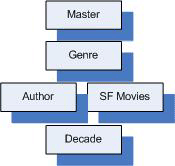
If we map the associations between these narratives, they would run like this:
- Genre Fiction>Science Fiction>Science Fiction Movies>Do Androids Dream of Electric Sheep? (4 levels)
- Genre Fiction>Science Fiction>P.K. Dick>The Novels of P.K. Dick - the 60s>Do Androids Dream of Electric Sheep? (5 levels)
The point of all this?:
- Narratives can be associated in any relationship that makes sense to your record set.
Given all this flexibility you might be asking why bother with the Hierarchical approach at all?
One downside of all this flexibility is that it is not possible to represent the relationships By Association visually as we do with the Hierarchical approach. If we look at the Hierarchy tab for the Science Fiction Movies narrative, we find that none of the associations are displayed:
As the number of associated narratives grows and individual narratives are associated here and there throughout the web of associations, it could become difficult to maintain perspective about the placement of narratives. If it is possible to stick to a logical hierarchy in which narratives at one logical level always point to the level above, this is less of an issue, but when narratives start relating elsewhere across a hierarchy it may become difficult to keep track of the relationships.
Next steps
Assuming that we have already assigned our narratives a Type, the first thing we should do is identify the relationships between them. There are many ways that our example narratives could be arranged, and here is one:
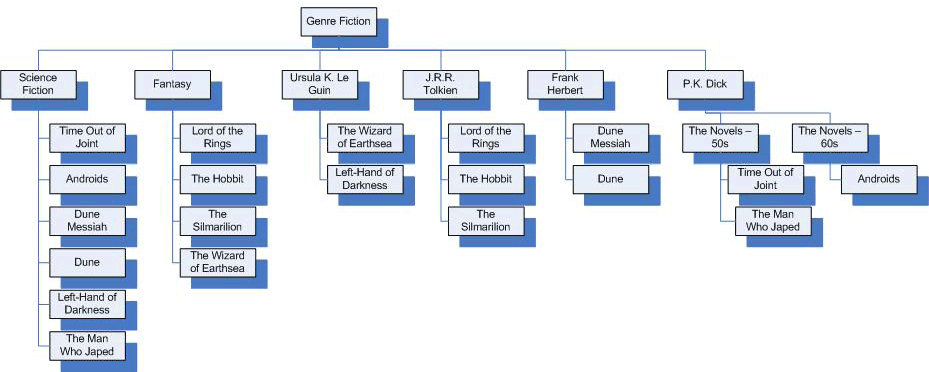
Notice that the structure we adopted for the Hierarchical approach wouldn't work for any author who wrote in more than one genre. Consider:

Recall that Ursula K. Le Guin has written both science fiction and fantasy novels, so if we used this structure we'd find fantasy and science fiction novels grouped together:
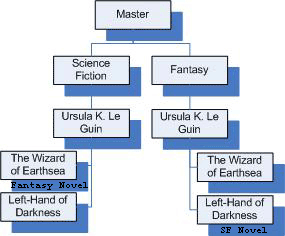
So, how do we make these associations in the Narratives module?
Associations are established on the Associations tab and are top-down. In other words, from the Science Fiction narrative record, we establish the association to each of the Science Fiction novels (below it in our hierarchy).
We do this by attaching records to the first vacant row in the Associated With: (Associated Narratives) table on the Associations tab.
Note: There are several ways to achieve this. The simplest method is to enter the title of a narrative in the Associated With cell of the first vacant row and press the TAB key. EMu searches the Narratives module using the details entered (see Attachments for more details).
Assuming we've established all the associations, let's look at the Associations tab for a sample of our narratives.
First, our Master narrative, Genre Fiction:
Here we've associated both Genre and Author narratives as indicated in our graphical representation of associations.
Note: Note: we determine the order that narratives are listed in this table. As we'll see, this also determines the order in which narratives will be listed on a website. To change the order of narratives in the Associated With table, simply select the number beside the row and drag it to the desired position.
If we look at the Associations tab for the Fantasy narrative, we find that Genre Fiction is now listed as an Associate. The Associate is the narrative that established an association with the current record.
Here we've established an association with the narratives about fantasy novels:
This is the Associations tab for the narrative Ursula K. Le Guin. As we see, it also includes the narrative about A Wizard of Earthsea:
A narrative can be associated anywhere and as many times as is appropriate.
On the Home page of our website, a visitor will see an option to browse the collection. If they select this, they will be taken to a page that displays the narrative about Genre Fiction. Beneath it they will find a list that includes the two genres (Science Fiction and Fantasy) and each author. Each item, which is a link to another page, may include a graphic from the associated narrative's Multimedia tab, and introductory text from its Narrative tab. (By default the introductory text is a specified number of characters taken from the start of the narrative text).
If our visitor selects Science Fiction, they will be taken to a page that holds the full narrative text about Science Fiction and includes a list of all the associated science fiction novels, with a graphic and introductory text for each, drawn from the Narratives module.
If they select the link for The Left Hand of Darkness, they will be taken to a page that holds the narrative about this science fiction novel.
See A practical example with Tips: The National Museum for more detail, including screenshots, of how narratives will display on a website. We also examine there how to control the order of narratives as they are listed on a web page.



